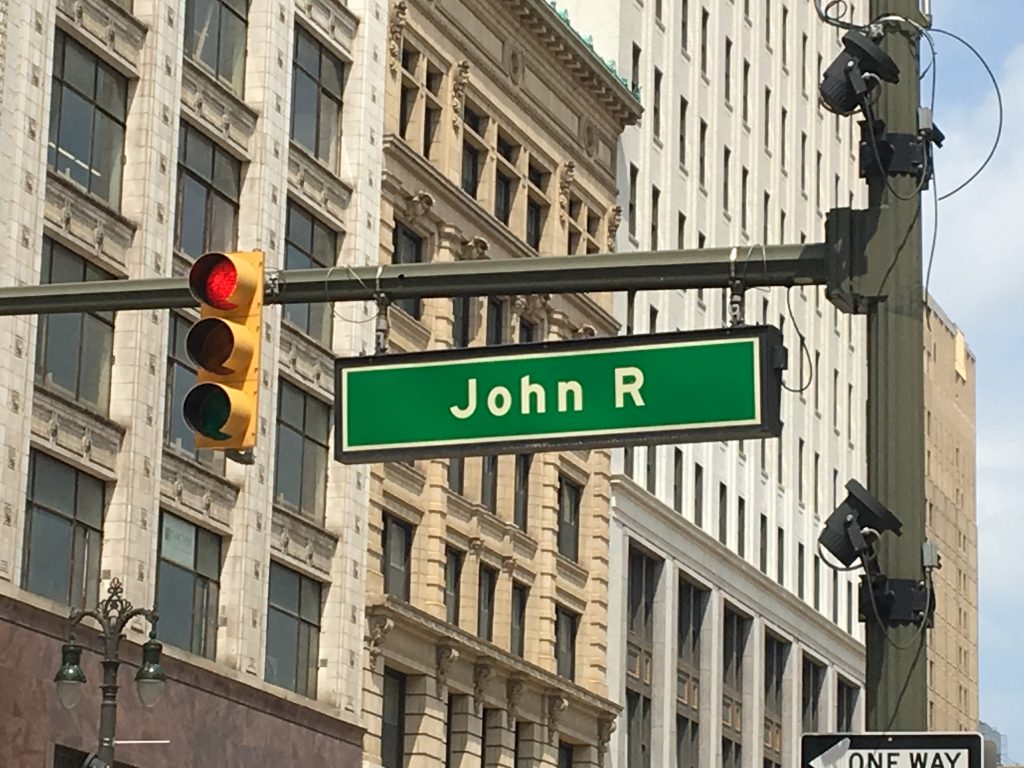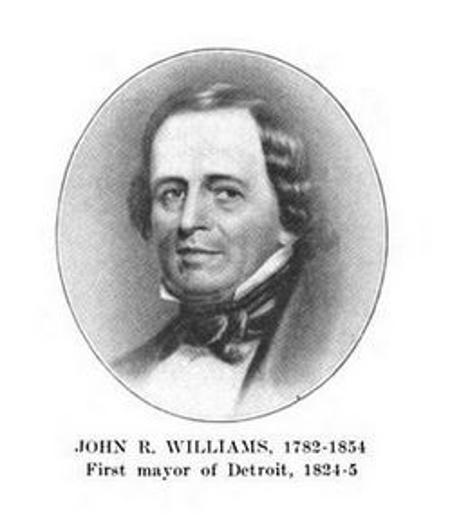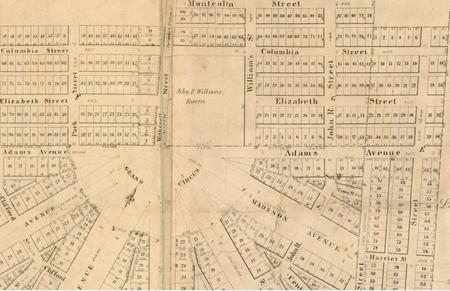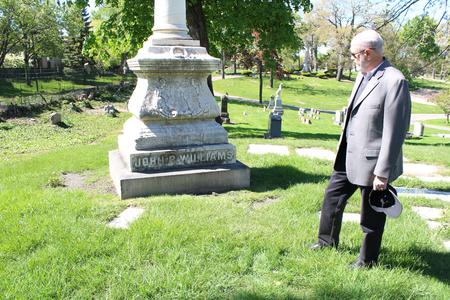CuriosiD: Who Was John R? [StoryMap]
Laura Herberg May 30, 2017A WDET listener wants to know about the man the street was named for.

WDET’s CuriosiD series answers your questions about everything Detroit. Subscribe to CuriosiD on Apple Podcasts, Spotify, NPR.org or wherever you get your podcasts.
In this episode of CuriosiD, listener Don Haffner asks…
“Why is it just ‘John R?’ Most people use the last name of a person, not the first name, and an initial, so, I always thought that was kind of strange. And also, who was John R., and why was the street named after him?”
The short answers
“John R” was actually John R. Williams who was born in Detroit in 1782 and died in 1854. He was a businessman, army general and politician from the city’s early days. After the War of 1812, he helped lobby for an elected delegate to represent the Michigan Territory. He drafted what is credited as the city’s first charter and, under its terms, he was elected the first mayor of Detroit.
As for the mysterious street name, John R. Williams originally named two streets in the city’s downtown area for himself: one “John R Street,” the other, one block away and parallel, “Williams Street.” In the 1890s — decades after his death — a street named Williams Avenue popped up on the city’s west side. To avoid confusion, Williams Street downtown was changed to Witherell Street, most likely for John R.’s contemporary — Michigan Supreme Court Justice Benjamin F.H. Witherell.
The story of John R., the Detroiter
Click through the StoryMap below to learn about the man and the street named in his honor.
Who was John R.?
John R. Williams was born in Detroit to an English father and French mother at a time when the city wasn’t much more than a fur trading post with ribbon farms. John R.’s father, Thomas Williams, died when his son was three. As an adolescent, John R. was taken in by his wealthy uncle, a man named Joseph Campau whose name you may recognize from the thoroughfare that runs through Hamtramck and Detroit. Under Campau’s care, John R. was educated and learned to write in English and French.
Matthew R. Thick, a lecturer in history at the University of Michigan – Flint, has written researched and written about John R.
“He was a tenacious fellow,” Thick says. “He was a hard worker, and that’s evident by the success of his business.”
Like his father had been, John R. was a merchant in Detroit. But, in actuality, he was a lot of things: a military man, a duel winner and a slave owner.
Detroit’s first elected mayor

John R. took on several civic duties including justice of the peace, official auctioneer and member of the Detroit board of education. His greatest achievement, however, might have been that he helped bolster the power of local government in the region.
Remember that for most of John R.’s life, Michigan wasn’t a state but a territory. University of Michigan archivist Mike Smith says the area, at the time, had a bad rap.
“People know of Detroit but Michigan itself is not considered a great place,” says Smith. “Many people think Michigan is just a giant swamp.”
“Many people think Michigan is just a giant swamp.” — Archivist Mike Smith on public perception of Michigan prior to 1812
Nonetheless, John R. took pride in the fact that he was born in Detroit. He thought the region was misunderstood by outsiders, and so it irked him that the territory was controlled mostly by prominent East Coasters. After the War of 1812, with the population growing, a committee he formed successfully petitioned the federal government for a delegate to be elected to represent the Michigan Territory. John R. ran for the position but lost to a newbie to the area, a man named William Woodbridge who today has a near-westside neighborhood named after him.
But John R. Williams was not shaken. In 1824, he helped draft what’s recognized as the city’s first charter. Then under its terms, he became Detroit’s first elected mayor. He went on to serve a total of six terms during the following years: 1824 – 1826, 1830 – 1831, 1844 – 1847.
Journalist Bill McGraw has studied and written about slavery in Detroit, which he says existed until as late as the 1820s.
“Almost all wealthy people in Detroit owned slaves. Usually just a few,” he says.
John R. was no exception. He and his uncle, Joseph Campau, ran a newspaper where a slave named Hector was their clerk. That paper, after a merger, became today’s Detroit Free Press.
“In Detroit the biggest slave owner was the Macomb family… as in Macomb County and Macomb Street,” says McGraw. “William Macomb owned about 26 slaves when he died in 1796.”
According to a BLAC Detroit article, at least eleven Detroit streets are named after slave owners.
But why just “John R”?
The land near Comerica Park north of Adams Street used to be Williams’ property, and he named many of the streets that now surround the ballfield. The street that intersects Adams a block west of John R, today, is called Witherell. But back in 1835 it was “Williams Street” (see map). Put these two together and you get “John R. Williams.” Unlike, say, John C. Lodge, who had all parts of his name put on one street, John R. Williams originally had his name split up into two roadways.

The reason we’re left with just “John R” on the street signs is that after Williams passed away in 1854, the city continued to grow. Sometime in the 1890s, a Williams Avenue appeared on the city’s west side. To avoid confusion, Williams Street downtown, was changed to Witherell, most likely for John R.’s contemporary — Michigan Supreme Court Justice Benjamin F. H. Witherell, but also possibly his father, James, who was also an important judge.
Today, Williams Avenue is Williams Street, and it’s still on the westside. But the existence of Williams Street downtown, just like the man it commemorated, is generally long forgotten. Yet, you could say, both helped pave the way for present-day Detroit.
But what did the “R” stand for?
Several modern day articles, including a website that explains how Detroit streets were named, say that John R. Williams was actually baptized “John Williams” but that he later added the “R” to distinguish himself. Whether that’s true is hard to say.
WDET was able to find a newspaper article from 1940 at the Burton Historical Collection that mentioned this story, but after contacting the Archdiocese of Detroit, the Archives of Michigan and the Detroit Historical Society for assistance, we were unable to locate a document to prove that he was indeed born without the middle initial.
We did find earlier letters written by John R. Williams that were signed without a middle initial, but that alone does not prove that he made up the “R.” If you know of a historical document that shows the truth either way, let us know at CuriosiD@wdet.org.
About the listener

Listener Don Haffner says John R Street stood out to him even decades ago when he would visit his grandfather at the jewelry shop he ran in the Metropolitan Building located on John R Street near Woodward Avenue in downtown Detroit.
Haffner was born in Detroit and went on to join the Peace Corps, serving in Korea. He then worked for the Pearl S. Buck Foundation in Korea and taught on American army bases. After returning to the states, he recorded textbooks for people with limited vision or dyslexia. Haffner recently authored Mukho Memories: A Peace Corps/Korea Memoir.
Sandra Svoboda contributed to the digital presentation of this story.
WDET’s CuriosiD is sponsored by the Michigan Science Center.
We want to hear from you!
Have a general question about Detroit? Ask us here or fill out the form below.
Support the podcasts you love.
One-of-a-kind podcasts from WDET bring you engaging conversations, news you need to know and stories you love to hear.
Keep the conversations coming. Please make a gift today.

